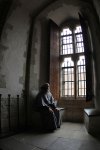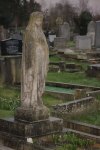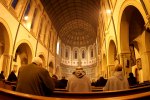
The following reflection was written on Holy Thursday, but concerns the whole Easter Triduum and Easter Itself.
This evening we have begun the Sacred Paschal Triduum with the Mass of the Lord’s Supper, which commemorates the institution of the Sacraments of Holy Orders and of the Eucharist. From here we will pass to the historical enactment of Our Lord’s great sacrfice and then on to His glorious victory over death. This will be my one Easter reflection for this blog and I will not return here until after the Easter Peace has concluded.
In actuality, the different moments of the Easter Triduum are most properly conflated under the title of Easter, since each of them is rightly qualified by the word paschal. Easter is our pasch, our passover, by which we pass from death to life in the crucified and victorious Savior. For Christ our pasch is sacrificed (1 Cor 5:7). In fact, it is almost a truism to say that the death of the Lord makes no sense without the resurrection and vice-versa. But it is also true to say that from the Lord’s own institution, we were never called to consider either His death or resurrection apart from the Eucharist.
The Hour of Christ
It was for these moments, or for this hour that He came (Jn 12:27). Everything, aside from the sin of his betrayers and murderers (among whom we are included), was executed according to his will and predetermined plan. His saving deeds have become the culminating moments of salvation history, but we do not merely remember them as belonging to the past, nor do we simply comprehend them in view of the transformation we all anticipate. As Cardinal Ratzinger has written, our liturgical participation belongs to a kind of middle moment, a “between-time” in which the institutional past is brought into the liturgical present and beyond by our carrying out the command he gave to His apostles at the last supper: This do for the commemoration of me (1 Cor. 11:24). The middle moment consists in the fact that our commemoration (a remembrance that is more than a memory) of the Lord’s saving mysteries looks forward to and effects our own transformation in grace, which is to be perfected in our own resurrection for which we are being prepared now by His Sacrifice and Sacrament of the Eucharist.
The three moments of the Triduum then—Eucharist, Passion and Death, Resurrection—are ordered to one another in such a way, that it is only in this liturgical life that Christ’s design for our salvation is fully realized. That the Paschal Triduum is the zenith of liturgical life only serves to underscore this truth.
A True Sacrifice
The Council of Trent taught that the Mass is “a true sacrifice and proper sacrifice,” and not a “bare commemoration of the sacrifice consummated on the cross,” but rather “a propitiatory sacrifice” (Session 22, cc. 1, 3). The difference between the sacrifice as it is offered on Holy Thursday and on Good Friday is the mode. On Holy Thursday at the Last Supper, Christ is immolated mystically in an “unbloody” manner, and on Good Friday, he is immolated historically and physically in a “bloody” manner upon the Cross. Our Lord institutes the Sacrifice of the Mass and the Sacrament of the Eucharist, as well as the Sacrament of Holy Orders the night before He died, because His explicit intention was to make all of us real and immediate participants in this One Sacrifice. Cardinal Ratzinger writes that in this way Our Lord made the semel (once for all) of His sacrifice semper (always) of liturgical life.
The difference between the first Mass celebrated by Our Lord Himself on the night before He died and those that take place after His resurrection through the ministry of His priests is the state of His humanity in respect to its glorification. On the night before He died, Our Lord’s Body in the consecrated host was not yet crucified and glorified, whereas after, and until the end of time, our Victim on the altar is not only the Savior on the Cross, but also the Victor who has come forth from the tomb and sits at the right hand of His Father, glorified in heaven.
The Mystery of Faith
The Church teaches that the Eucharist is The Mystery of Faith. This notion comes from the institutional narrative itself into which these words are inserted, specifically from the consecration of the chalice:
HIC EST ENIM CALIX SANGUINIS MEI, NOVI ET AETERNI TESTAMENTI:
MYSTERIUM FIDEI:
QUI PRO VOBIS ET PRO MULTIS EFFUNDETUR IN REMISSIONEM PECCATORUM.
THIS IS THE CHALICE OF MY BLOOD OF THE NEW AND ETERNAL COVENANT:
THE MYSTERY OF FAITH:
WHICH IS BEING SHED FOR YOU AND FOR MANY FOR THE FORGIVENESS OF SINS.
This is the text as it is taken from the ancient liturgical usage. I will refrain from comment on the change introduced into the new liturgy, especially in the English translation, as it does not pertain to my purpose here.
The words The Mystery of Faith have been introduced by the liturgical tradition into the scriptural texts as an appositive attached to the reference concerning chalice of the blood of the new and eternal covenant. There are a number of theories as to why the words were inserted without strict adherence to the biblical text and without explantion, and as to what exactly they were intended to mean. One of the great liturgists of the modern age, Joseph A. Jungmann, S.J., has written that no certain answer can be ascertained on either score. However, the magisterium has commented on the text, and has told us that it refers to the ineffable mystery of the Eucharist itself. Thus the narrative might be punctuated as follows: This is the chalice of My Blood of the new and eternal covenant—The Mystery of Faith—which is being shed for you and for many for the forgiveness of sins.
All this being said, for the sake of my little Easter reflection, and without intending to do anything more than to offer a meditation, I would like to explore more deeply the meaning of this unexplained insertion of mysterium fidei into the biblical narrative.
Ineffable Mystery
We know that the one sacrifice of Christ is made present in the Mass, that Jesus suffering and victorious is both the Priest and Victim. We know that we are present at Calvary and that the heavens have opened so that not only is the past made present, but that we are entering into the hour of Christ’s glorification, so that we are also present at the heavenly liturgy, singing with the Seraphim: Sanctus, Sanctus, Sanctus, Dominus Deus Sabaoth. We know that the double consecration during the canon of the Mass symbolizes the separation of Christ’s Blood from His Body in such a way that the one Sacrifice is made present once again:
For by the “transubstantiation” of bread into the body of Christ and of wine into His blood, His body and blood are both really present: now the eucharistic species under which He is present symbolize the actual separation of His body and blood. Thus the commemorative representation of His death, which actually took place on Calvary, is repeated in every sacrifice of the altar, seeing that Jesus Christ is symbolically shown by separate symbols to be in a state of victimhood (Mediator Dei, 70).
But it is only at the moment at the consecration of the chalice that the liturgical tradition has left us with this deliberate insertion of the words, The Mystery of Faith, and without explanation either in the liturgical texts themselves nor any of the written and oral tradition of the Church from the early times in which this liturgical formulary came to be. Our Lord has already been made present on the altar by means of the consecration of the Host, but in the consecration of the Chalice the symbolism of the separation of His Blood from His Body has been made perfect. Perhaps the inexplicable insertion of these words can be construed as providentially indicating the mysticism of the Sacrifice and the Sacrament, the fact that past, present and future have, in a sense, coalesced and we are somehow participants in each moment, facing the East from whence the Orient on High has come and toward which we are processing, led by our High Priest and King, Jesus Christ.
The priest, in a sense, pauses or interrupts the institutional narrative, in a rubrical sense of awe, and comments on the stupendous reality before us. We have achieved the Holy Grail. We have arrived at the throne of God. How terrible is this place? this is no other but the house of God, and the gate of heaven (Genesis 28:17). Mysterium fidei!
The Eternal Word has undergone a transformation much like the one by which He became Incarnate. Every Mass is a little Christmas. But also the Lamb has been sacrificed and we are once again at the foot of the Cross. The bread and wine have become the Body and Blood of Christ, and we, by some awesome privilege, are now called to enter the mystery and consume the sacrifice so that we might also be transformed into that which we consume. We are no longer fixed in our place in history but are incorporated into the hour of Christ, and thus all time has a different significance and a greater power.
The Holy Grail
No wonder the Chalice of the Last Supper has become both the object of veneration and the inspiration for myths. It is a mystical object because it contains a secret—not the gnosis of the heretics or the ancient, arcane and occult mysteries of the Freemasons, but the secret of our own transformation in grace.
In the most Christian version of the Arthurian legend of the Holy Grail, Quest del Saint Graal, probably written by a Cistercian monk at the beginning of the thirteenth century, the Holy Chalice is symbol of grace, or such at least is the interpretation of Etienne Gilson. Medievalist Pauline Matarasso, on the other hand, asserts that the Grail of the Quest doubly manifests the mystery of the Eucharist in the Last Supper and the coming of the Holy Spirit at Pentecost.
However the myth is to be interpreted, the historical Grail is a vessel in which a mystery is contained, a secret, and in the first case that mystery is the Blood of Christ that has been shed for us. But it is also our participation in the mystery as well. The chalice of benediction which we bless, is it not the communion of the blood of Christ? (1 Cor 10:16). The period immediately after the Easter Triduum in which the newly baptized are still reeling from their full initiation into the Sacred Mysteries is called the mystagogia, in which they are called to more deeply penetrate and assimilate the mysteries they have newly experienced. There is a need for this precisely because the Eucharist and our participation in it is the fundamental and universal mysticism of the Church. Only those who can learn silence, adoration and most of all, who can enter in to the gift of salvific suffering are able to enter into the mystery of the Holy Grail.
If it is true then, in some sense that The Mystery of Faith is the Eucharist and our participation in the Sacred Mysteries, and if it is also true that the Chalice of Benediction, the Holy Grail, over which myserium fidei is spoken, is the mystery of grace and redemption, then might we not look to the most sublime vessel of grace in order to penetrate the mystery and enter into the secret? Indeed, the mystics who have experienced the events of the Triduum in an extraordinary way, albeit in a way that in no sense constitutes part of the deposit of faith, place a special emphasis on the Eucharistic communion of Our Lady at the Last Supper on Holy Thursday. She is often said to have been communicated by angels, as for example, Ven. Mother Maria of Agreda writes that St. Gabriel was sent to Her from the cenacle to give Her Holy Communion immediately after Our Lord Himself had consumed the sacred species. In fact, the venerable mother says that the Sacred Host remained unconsumed in the body of the Blessed Virgin until the first Mass of St. Peter after the Resurrection.
Womb and Tomb
There is a remarkable passage of the great English Jesuit poet, Gerard Manley Hopkins from his retreat notes apropos of this extraordinary grace of the Blessed Virgin. In his notes he comments on the passage of the Spiritual Exercises of St. Ignatius concerning the apparition of Our Lord to His Blessed Mother at the resurrection. There we read the following:
‘In corpore et anima’—On the pregnant principle expressed in the Mysteries and in this very one we cannot doubt at the Last Supper Christ invisibly but sacramentally communicated the Blessed Mother (as many estatics and others have been communicated) by the hands of angels or otherwise. After this she would have fasted till the Resurrection and the Sacred Host have lain in her breast unconsumed. In her then as well as on the cross Christ died and was at once buried, her body his temple becoming his sepulcher. At his rising the soul entered the body in her as in the sepulcher and, issuing from her breast, the two presences passed into one. And at the same time the windingsheet left empty fell upon itself in the sepulcher and the empty accidents were consumed in the Blessed Virgin.
“Warm laid grave of a womb life grey;/ Manger, maiden’s knee” is how Hopkins refers to the trajectory of Christ’s Body and Blood existence from birth to death (“The Wreck of the Deutchland,” st. 7, ll. 3, 4). And in the context of his contention concerning Mary’s Holy Thursday communion, we should more clearly see the enclosed space of Our Lady’s Virginal womb, where the Eternal Word is enfleshed, as the foreshadowing of the sealed tomb and another manifestation of that inviolate Garden of Paradise which is Her Immaculate and Sorrowful Heart.
Elsewhere in his retreat notes, Hopkins suggests that the defense of this mystery or secret is, in fact, the great cosmic battle in which all souls are perpetually engaged. As he reflects on chapter 12 of the Apocalypse where St. Michael attacks the fallen angels he writes: “. . . It was a sort of crusade undertaken in defense of the woman in whom the sacrificial victim had lain and from whom he had risen, a sort of Holy Sepulchre and a heavenly Jerusalem. . .”
I certainly would not blame anyone who says that all this is just pious poetry from a Marian enthusiast. Yet poetry says something true, even if not literally or historically, though many aspects of sacred history are also poetic. St. Anthony Mary Claret was well known to carry the Blessed Sacrament continually in his body as in a tabernacle. And it is a patristic teaching that the miracle of the Virgin Birth (“womb life grey”) is exactly parallel to the escape of Our Lord from the sealed tomb (“warm laid grave”).
The Secret of Mary
Indeed, the New Garden of Paradise is the Heart of Mary and it is like the enclosed space of the Cenacle where the first Mass was celebrated. It is like Garden of the Agony of Jesus where He resigned Himself to the Chalice of Suffering. And it is like the Garden of the Passion and Resurrection, where the New Tree of Life grows and bears fruit. Her virginal womb is truly the Virgin Earth from which grows forth the Tree of Life, and, one way or another, it is the exemplar for the enclosed space in which the Victim and Victor is laid and from which He rises. It is the true Grail of the Blood of Christ where we enter into The Mystery of Faith. St. Louis de Montfort writes that devotion to Mary is the secret that the Holy Spirit unseals for us (The Secret of Mary, 20). We are invited to enter this Enclosed Garden and Fountain Sealed, if we are willing to be humble in the face of the mysterium fidei.
The Easter mystery is all about sacrificial love, Christ’s, first of all, then ours in the Heart of the Immaculate Coredemptrix, the one in whom the mysteries we celebrate are fully realized. The Great Sacrifice makes Jesus present as our food, and in Him, in our participation in that Sacrifice through Holy Communion, we are incorporated into the mystery, mysticism and transformation in preparation for our own resurrection. This is what we celebrate as we witness the Bride of Christ decked out in all Her liturgical glory. This is the real secret of liturgical reform and its only real object.
May the Peace of Easter be yours.


















 In my
In my 


